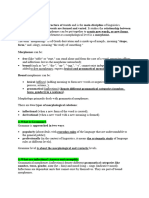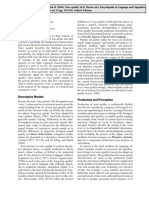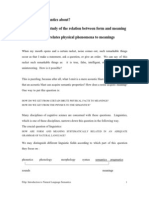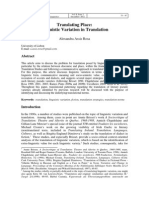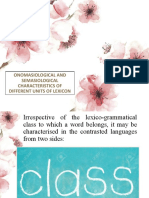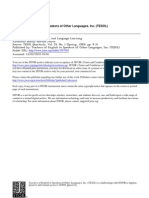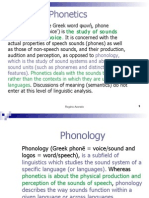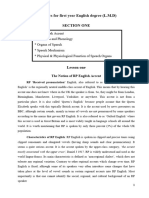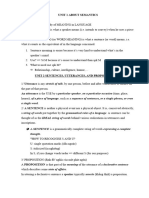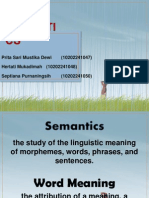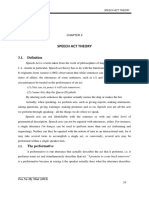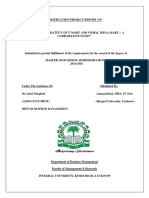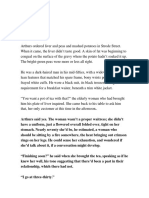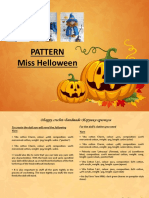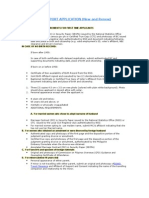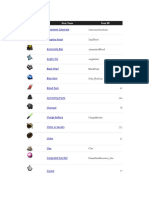0 ratings0% found this document useful (0 votes)
471 viewsParalinguistics and Suprasegmentals
Paralinguistics and Suprasegmentals
Uploaded by
Candy Abigail Areja1) Paralinguistics is the study of vocal and non-vocal signals beyond verbal messages, including tone, pitch, rhythm, timber, loudness, facial expressions, eye contact, gestures, and proxemics.
2) Suprasegmentals refer to elements of speech longer than individual sounds or phonemes, including stress, intonation, tone, pitch accent, and rhythm.
3) Effective communication involves the strategic use of paralinguistic and suprasegmental elements to convey meanings, emotions, and attitudes.
Copyright:
© All Rights Reserved
Available Formats
Download as PDF, TXT or read online from Scribd
Paralinguistics and Suprasegmentals
Paralinguistics and Suprasegmentals
Uploaded by
Candy Abigail Areja0 ratings0% found this document useful (0 votes)
471 views93 pages1) Paralinguistics is the study of vocal and non-vocal signals beyond verbal messages, including tone, pitch, rhythm, timber, loudness, facial expressions, eye contact, gestures, and proxemics.
2) Suprasegmentals refer to elements of speech longer than individual sounds or phonemes, including stress, intonation, tone, pitch accent, and rhythm.
3) Effective communication involves the strategic use of paralinguistic and suprasegmental elements to convey meanings, emotions, and attitudes.
Original Description:
A Report on Oral Presentation
Copyright
© © All Rights Reserved
Available Formats
PDF, TXT or read online from Scribd
Share this document
Did you find this document useful?
Is this content inappropriate?
1) Paralinguistics is the study of vocal and non-vocal signals beyond verbal messages, including tone, pitch, rhythm, timber, loudness, facial expressions, eye contact, gestures, and proxemics.
2) Suprasegmentals refer to elements of speech longer than individual sounds or phonemes, including stress, intonation, tone, pitch accent, and rhythm.
3) Effective communication involves the strategic use of paralinguistic and suprasegmental elements to convey meanings, emotions, and attitudes.
Copyright:
© All Rights Reserved
Available Formats
Download as PDF, TXT or read online from Scribd
Download as pdf or txt
0 ratings0% found this document useful (0 votes)
471 views93 pagesParalinguistics and Suprasegmentals
Paralinguistics and Suprasegmentals
Uploaded by
Candy Abigail Areja1) Paralinguistics is the study of vocal and non-vocal signals beyond verbal messages, including tone, pitch, rhythm, timber, loudness, facial expressions, eye contact, gestures, and proxemics.
2) Suprasegmentals refer to elements of speech longer than individual sounds or phonemes, including stress, intonation, tone, pitch accent, and rhythm.
3) Effective communication involves the strategic use of paralinguistic and suprasegmental elements to convey meanings, emotions, and attitudes.
Copyright:
© All Rights Reserved
Available Formats
Download as PDF, TXT or read online from Scribd
Download as pdf or txt
You are on page 1of 93
Paralinguistics and Suprasegmentals
AREJA | DELA CRUZ | SANCHEZ | FERNANDEZ | NEPOMUCENO | VALLINAS
Paralinguistics
Is the study of:
Vocal
Non-vocal
signals that are beyond the verbal message or
speech.
How do you convey your message?
Tone
Pitch
Rhythm
Timber
Loudness
Effective Use Of Paralinguistics
Try to vary your tone
- Awareness of the underlying message
Concentrate on how you phrase
- Tones and facial expressions emphasize ideas
Use soft/low voice that your participants can hear
Forms of Non-vocal
Communication
Facial Expression
Facial Expression
Motions of muscles beneath the faces skin
Convey emotional state of an individual
Convey social information between humans
Maybe voluntary or involuntary
Stronger understanding of what others feel
Examples of Facial
Expression
Shocked
Disgust / Revolting
Confused
Hunger / Sadness/ Discomfort
Disappointment
Dismay
Effective use of Facial Expression
Smile regularly
Smiling is often contagious
Eye Contact
Eye Contact
Eyes : Windows to the soul
Helps regulate the flow of communication
Important part of communication
Can establish relationship between the parties
Examples of Eye Contact
Eyes Gaze
How eyes focus on speaker
Avoiding Eye Contact
evading or trying to hide something
Breaking Eye Contact
distracted, uncomfortable, disinterested
Prolonged Eye Contact
confrontational, intimidating, threatening
Looking Directly to Eyes
interested, paying attention
Looking Up and Down
sizing up
Blinking
Rapid closing and opening of eye lids
Blinking
Rapid blinking uncomfortable, lying, fluttered
Blinking on pause listening carefully
Single blink surprised, unbelievable
Pupil Size
Dilation and contraction of pupils
Pupil Size
Bedroom Eyes interested, attracted, sexually aroused
Contracted Pupils disinterested, threatened
Which is more attractive?
Effective use of eye contact
Maintain eye contact
Intervals of eye contact:
lasting 4 to 5 seconds
Gesture
Gesture
Visible bodily actions that has meanings
Can sometimes substitute speech
Shows your intentions and emotions
Reinforce and support your words
Examples of Gesture
Thumbs Down
Bad
Rude way of saying failure
To not approve
Stop
The Dog Call
Summoning someone towards you
tempting woman to her man
O.K
everything is good, well or O.K.
Zero (Australia)
Homosexual (Turkey)
I am Running Out of Time
Hand Kissing
respect
Face Palm
Frustration and embarrassment
Effective use of gestures
Be lively
Be animated
Reference
http://en.wikipedia.org/wiki/Eye_contact
http://en.wikipedia.org/wiki/Gesture
http://en.wikipedia.org/wiki/Facial_expression
Posture and Body Orientation
Important aspect of non verbal communication
Conveys ones feelings and attitudes
Standing Sitting Slouching Lying
Standing vs. Sitting
Signals confidence and
honesty
Stand to present when:
Formalizing a group
Filling the space, creating
a dynamic movement
while speaking
Drawing attention
Signals Intimacy and
informality
Sit to present when:
Focusing on building trust and
rapport first
Drawing people in
Appearance
Impression
Clothes, colors, hairstyle, etc.
Dress Code: Casual
Laid back
Translates to road trips, mall visits,
school, etc
Dress Code: Smart Casual
Includes trousers, collared shirt,
leather loafers, blouse, sweater, and
the like
Informal but neat
Its like wearing business clothes in a
relaxed fashion
Dress Code: Business
Includes long sleeves, tie slacks,
business skirts, blazers, and the
like
lets work like a boss
Dress Code: Formal
Includes evening gowns,
tuxedo jackets, black shoes,
high-heels, and the like
Elegance and beauty
Can be worn during formal
events like formal parties,
formal gatherings, and the like
Effective Use of Appearance
Different colors can invoke different moods
Warm colors: vary from warmth to anger and hostility
Cool colors: vary from calm to feelings of sadness
Appearance can also change physiological reactions,
judgment, and interpretations
Proxemics
also known as personal space
Social
Personal
Intimate
Distance Between Faces Tone of Voice Type of Message
Very close (3-6 inches)
Close (8-12 inches)
Soft whisper
Audible whisper
Top secret or sensual
Very confidential
Neutral (20-36 inches) Soft voice, low volume Personal subject matter
Neutral (4.5-5 feet) Full voice Non-personal information
Across the room (8-20 feet) Loud voice Talking to a group stretching the
limit
Effective Use of Proxemics
Move around the area
- May increase interaction
Closeness allows better eye contact
- May increase opportunity for participants to speak
Game
3. What posture/position is more
effective if you want to formalize
a group?
4. What dress code is conveyed
by this:
informal but neat
Suprasegmentals
"It a'int what you say but the way you say it."
Segments and Segmentals
Vowels
Consonants
Phonemes
Phones
Allophones
Suprasegmental vs. Segmental
longer stretches of speech, such
as rhythm and voice quality
individual sounds
Suprasegmentals
Length or quantity
Tone
Pitch accent
Stress
Intonation
STRESS
giving emphasis on certain syllable/s or
word/s
can be classified as word and
phrase or sentence stress
WORD STRESS
stress on syllable/s marked by an
acute accent ()
WORD STRESS
1. Stress on one syllable
change of meaning
a)from noun to another noun
desert and dessert
b)from noun to verb and vice versa
cnduct and condct
WORD STRESS
c)from single word to two words
hotdog and hot dog
WORD STRESS
in other languages:
Filipino
o sma and sam
Spanish
o trmino (terminal), termno (I finish.), and termin
(he finished.)
WORD STRESS
2. Stresses on more than one syllable
main or primary stress marked by accute accent ()
secondary stress marked by grave accent (`)
WORD STRESS
examples:
a. rsigntion
b. sstemtic
c. rvoltion
d. fndamntal
PHRASE OR SENTENCE STRESS
stress on word/s
shift in meaning
example: I love you.
I love you.
I love you.
I love you.
WAYS ON PUTTING STRESS
1. Length
2. Pause
3. Volume
4. Pitch
Intonation
variation of spoken pitch over
an entire phrase or sentence
Pitch Contours
serves as a tracking device
that perceives pitch
over a period of time
Pitch Contours
Example:
What did you put in my drink, Jane?
What did you put in my drink, Jane?
Functions of Intonation
Attitudinal
Accentual
Grammatical
Discourse
Types of Intonation
Rising Intonation
Falling Intonation
Level Intonation
Transcription of Intonation
\ Falling
/ Rising
\/ Dipping (fall - rise)
/\ Peaking (rise - fall)
_ Level
Falling
definite, final
used in WH- questions
Examples:
Mary likes John.\
She hates swimming\.
What does it say?\
Rising
indicates uncertainty, curiosity
used in yes-no questions
Examples:
Mary likes John?/
Did you finish your homework?/
Dipping
surprised, scepticism
Also used in tag questions
Examples:
She's nice,\ isnt she?\
The singer was good,\ wasnt he?\
Peaking
Emphatic statement
Also used in tag questions
Example:
I'd /love some\!
Shes nice,\ isnt she?/
Level
boredom, not interested
Example:
Cool.
Great.
Rhythm
Relationship between stressed and unstressed syllables
Patterns of combination of stressed and unstressed
syllables
The liaison or other phonological structures
Examples:
The boy is interested in enlarging his vo"cabulary.
Great progress is made "daily.
Rhythm
Language Types (Rhythm)
Stress-timed
Syllable-timed
Syllable-timed
duh-duh-duh-duh-duh-duh
Stressed-timed
English is a stress-timed language
duh-DUH-duh-DUUUH-duh
duh-duh-DUUUH
Stressed-timed
Dogs chase cats.
The dogs chase cats.
The dogs chase the cats.
The dogs will chase the cats.
The dogs will be chasing the cats.
Questions
References
http://grhttp://www.slideshare.net/trinawong/nonverbal-communication-
3296384ammar.about.com/od/pq/g/paralinguisticsterm.htm
http://www.slideshare.net/trinawong/nonverbal-communication-3296384
http://hrcommunication.blogspot.com/2007/06/body-posture-and-orientation.html
http://en.wikipedia.org/wiki/Posture_(psychology)
http://www.goddessofpublicspeaking.com.au/blog/public-speaking/sitting-versus-standing-position-
yourself-powerfully-when-you-speak/
http://www.ncbi.nlm.nih.gov/pmc/articles/PMC2811283/
http://www.emilypost.com/everyday-manners/your-personal-image/69-attire-guide-beach-casual-to-
white-tie
Paralinguistics
References
http://www.phon.ox.ac.uk/jcoleman/PROSODY.htm
http://tkacmaz.files.wordpress.com/2014/02/suprasegmentals.pdf
http://web.ntpu.edu.tw/~language/workshop/2010-3.pdf
Suprasegmentals
You might also like
- The Wolf's BrideDocument32 pagesThe Wolf's BrideThomas100% (2)
- Scout Standard NotesDocument48 pagesScout Standard Notesasadshareef2005No ratings yet
- Морфологія (теорія)Document14 pagesМорфологія (теорія)ulaihendiNo ratings yet
- Descent 2nd Edition Act I Shop ItemsDocument5 pagesDescent 2nd Edition Act I Shop ItemsgustavNo ratings yet
- Language GuideDocument34 pagesLanguage Guideمحمد محمدNo ratings yet
- Voice Quality - EslingDocument5 pagesVoice Quality - EslingFelipe TabaresNo ratings yet
- Readings About ForegroundingDocument2 pagesReadings About ForegroundingShekinahNo ratings yet
- 89112103Document14 pages89112103Martin Hope100% (1)
- Blackmoor CorebookDocument242 pagesBlackmoor CorebookBryan C.88% (16)
- Suprasegmentals Between English and TagalogDocument7 pagesSuprasegmentals Between English and TagalogMarielMiaDomingoForonda100% (1)
- Chapter 1 What Is MeaningDocument30 pagesChapter 1 What Is MeaningzenijasmineNo ratings yet
- 2-Is Linguistics A ScienceDocument14 pages2-Is Linguistics A Sciencealex darudeNo ratings yet
- Pragmatics in HyperboleDocument4 pagesPragmatics in HyperboleSparrow WingsNo ratings yet
- Idiolect Sociolect PresentationDocument15 pagesIdiolect Sociolect Presentationdarren.mcquayNo ratings yet
- A Brief History of Psycholinguistics and Psycholinguistic Language ResearchDocument3 pagesA Brief History of Psycholinguistics and Psycholinguistic Language ResearchSiddiq Khan67% (3)
- Semantics Chapter 1Document12 pagesSemantics Chapter 1Милена СтојиљковићNo ratings yet
- Root Antonyms (Absolute Antonyms) Are Antonyms Having Differrent Roots, E.GDocument9 pagesRoot Antonyms (Absolute Antonyms) Are Antonyms Having Differrent Roots, E.GMasha RadkoNo ratings yet
- The Idea of Feature Systems That We Have Been Talking About in Relation To Phonetics Also Lends Itself Quite Handily To The Description of NaturalDocument59 pagesThe Idea of Feature Systems That We Have Been Talking About in Relation To Phonetics Also Lends Itself Quite Handily To The Description of NaturalhiooNo ratings yet
- Phonetics PPT Week 1Document26 pagesPhonetics PPT Week 1Ahmed Ali JanNo ratings yet
- Phraseology ReferatDocument13 pagesPhraseology ReferatDaniela Dedov100% (1)
- Translating Place: Linguistic Variation in Translation"Document23 pagesTranslating Place: Linguistic Variation in Translation"aassisrosaNo ratings yet
- Name of Course: Psychology Course Code: BBA 3763 Semester: 4 Total Lessons: 11Document52 pagesName of Course: Psychology Course Code: BBA 3763 Semester: 4 Total Lessons: 11Shraddha KarkiNo ratings yet
- Introduction To The Study of Meaning in LanguageDocument40 pagesIntroduction To The Study of Meaning in LanguageMaida KhanNo ratings yet
- Dissimilation: A. DefinitionDocument2 pagesDissimilation: A. DefinitionayualitanthariNo ratings yet
- Onomasiological and Semasiological Characteristics of Different Units of LexiconDocument31 pagesOnomasiological and Semasiological Characteristics of Different Units of LexiconНаташа КлокNo ratings yet
- Catford JC 1975 Ergativity in Caucasian LanguaguesDocument59 pagesCatford JC 1975 Ergativity in Caucasian LanguaguesnellyUNNo ratings yet
- HYPONYMY PresentationDocument10 pagesHYPONYMY PresentationJahirul IslamNo ratings yet
- Mary Bucholz and Kira Hall Sociocultural LinguisticsDocument31 pagesMary Bucholz and Kira Hall Sociocultural LinguisticsMargareta BasaraginNo ratings yet
- Decoding Speech Prosody in Five LanguagesDocument18 pagesDecoding Speech Prosody in Five LanguagesmarkosNo ratings yet
- Week 7 Semantics of Phrase and Sentence - Lecture Notes2022 2023Document3 pagesWeek 7 Semantics of Phrase and Sentence - Lecture Notes2022 2023Maria TeodorescuNo ratings yet
- Rhythm & IntonationDocument17 pagesRhythm & IntonationqamaNo ratings yet
- The Natural Semantical Metalanguage Theo PDFDocument7 pagesThe Natural Semantical Metalanguage Theo PDFHalla KomdanNo ratings yet
- Bonny Norton Peirce - Social Identity and InvestmentDocument24 pagesBonny Norton Peirce - Social Identity and InvestmentAllie SANo ratings yet
- The Hierarchical Model of Approach-Avoidance MotivationDocument6 pagesThe Hierarchical Model of Approach-Avoidance MotivationRhix RheeNo ratings yet
- Aziza Radhy Ma Candidate The Order of Morphs and Morphemes E.K.Brown and J.E.MillerDocument7 pagesAziza Radhy Ma Candidate The Order of Morphs and Morphemes E.K.Brown and J.E.MillersaifNo ratings yet
- Discourse Markers. Descriptions and TheoryDocument7 pagesDiscourse Markers. Descriptions and TheoryJiarui LuNo ratings yet
- Approaches To DiscourseDocument26 pagesApproaches To Discoursenabeelajaved100% (1)
- Inflection & Affixes Pres NewDocument27 pagesInflection & Affixes Pres Newtonny utomoNo ratings yet
- Unit 5 PredicatesDocument30 pagesUnit 5 PredicatesQuang NguyễnNo ratings yet
- HengeveldDocument100 pagesHengeveldmantisvNo ratings yet
- Phonetics & PhonologyDocument9 pagesPhonetics & PhonologyRogerio AzeredoNo ratings yet
- M Lynne Murphy 2003 Semantic Relations ADocument6 pagesM Lynne Murphy 2003 Semantic Relations AChinh DangNo ratings yet
- 11 FunctionalismDocument8 pages11 FunctionalismLiv Tarigan100% (1)
- The Ethnography of SpeakingDocument22 pagesThe Ethnography of SpeakingHibaalgurjia100% (1)
- Couper Kuhlen 01Document19 pagesCouper Kuhlen 01Kevin JohnsonNo ratings yet
- Phonetic SoundsDocument44 pagesPhonetic SoundsPrasangiNo ratings yet
- The Functions of LanguageDocument7 pagesThe Functions of LanguageFlorinNo ratings yet
- Ross 1967 Constraints On Variables in SyntaxDocument529 pagesRoss 1967 Constraints On Variables in SyntaxIker SalaberriNo ratings yet
- X Bar TheoryDocument5 pagesX Bar TheoryPatrycja KliszewskaNo ratings yet
- First Year LMD Phonetics Lesson 1&2Document3 pagesFirst Year LMD Phonetics Lesson 1&2GrX4 ChemsoNo ratings yet
- SemanticsDocument8 pagesSemanticsphamngan150802No ratings yet
- Home Work MorphemeDocument12 pagesHome Work MorphemeMuhamad AzhaerNo ratings yet
- End-Of-Term Assignment: Comparative Linguistics CourseDocument16 pagesEnd-Of-Term Assignment: Comparative Linguistics CourseThanh Phuong Nguyen VuNo ratings yet
- Lingg 206: Grammatical Analysis I Angelina A. AquinoDocument25 pagesLingg 206: Grammatical Analysis I Angelina A. AquinoAkinoTenshi100% (1)
- Intonation in Communication SkillDocument19 pagesIntonation in Communication SkillRajesh SinglaNo ratings yet
- SemanticsDocument27 pagesSemanticstyaschoNo ratings yet
- AssimilationDocument23 pagesAssimilationfokin avocadoNo ratings yet
- Phonemic AnalysisDocument17 pagesPhonemic AnalysisMARIAN FEL DEMALATA100% (1)
- 3 Speech Act TheoryDocument9 pages3 Speech Act TheoryTuyết Ngân Nguyễn BạchNo ratings yet
- An Analysis of Taboo Words Used by Characters in Freedom Writer MovieDocument6 pagesAn Analysis of Taboo Words Used by Characters in Freedom Writer MovieAsbar San100% (1)
- Non Verbal CommunicationDocument31 pagesNon Verbal Communicationmubeenazhar156No ratings yet
- Enunciation. ElopreDocument37 pagesEnunciation. ElopreJoana EboñaNo ratings yet
- Session 4 Non-Verbal CommunicationDocument45 pagesSession 4 Non-Verbal Communicationashith8095382766No ratings yet
- Kine SicsDocument26 pagesKine SicsRajani Krishnan SureshNo ratings yet
- Architecture of Marikal PDFDocument14 pagesArchitecture of Marikal PDFKoushali BanerjeeNo ratings yet
- Dept - of Business ManagementDocument83 pagesDept - of Business ManagementOmiNo ratings yet
- GarmentsDocument6 pagesGarmentsWilson AgustinNo ratings yet
- William Trevor - On The StreetsDocument18 pagesWilliam Trevor - On The StreetsEnanito SaltarinNo ratings yet
- Skin Deep Tattoo Magazine - February 2014 UK PDFDocument100 pagesSkin Deep Tattoo Magazine - February 2014 UK PDFPaul Goggin100% (2)
- SifaDocument4 pagesSifaMas TianNo ratings yet
- Developing An Innovative Business Model of Denim in Upcycling and ThriftingDocument62 pagesDeveloping An Innovative Business Model of Denim in Upcycling and ThriftingKaren SouzaNo ratings yet
- Shopping ExpresiiDocument3 pagesShopping ExpresiiBogdan ZancuNo ratings yet
- Risk Assessment: Welding: Rev.0 Dec.07 Form: EEHSP-02) Appendix 2 (Document2 pagesRisk Assessment: Welding: Rev.0 Dec.07 Form: EEHSP-02) Appendix 2 (MohammedNo ratings yet
- Presentation Made On Towel Manufacturing CompanyDocument10 pagesPresentation Made On Towel Manufacturing CompanyArchana GrewalNo ratings yet
- ShukaDocument8 pagesShukaMamello Meme Bolofo100% (1)
- Pattern Miss HelloweenDocument18 pagesPattern Miss HelloweenPaulaUkita67% (3)
- Philippine Passport ApplicationDocument5 pagesPhilippine Passport ApplicationNemesio Mandac IINo ratings yet
- A Study of Factors Affecting To The Sewing Employees Efficiency of Apparel Industry in Badulla DistrictDocument14 pagesA Study of Factors Affecting To The Sewing Employees Efficiency of Apparel Industry in Badulla DistrictInternational Journal of Business Marketing and ManagementNo ratings yet
- Silvia The Sadist - SifaxnumidaDocument206 pagesSilvia The Sadist - SifaxnumidaSu ZhiNo ratings yet
- The Voyage of The James CairdDocument16 pagesThe Voyage of The James Cairdmonica.porterNo ratings yet
- 09 20 11 Denotation Connotation 3 PoetryDocument5 pages09 20 11 Denotation Connotation 3 PoetryEdelmen AnduyanNo ratings yet
- Kid S Wear CwholesalerDocument60 pagesKid S Wear Cwholesalerpranub100% (2)
- Hávamál: The Sayings of HárDocument22 pagesHávamál: The Sayings of HárGustavo AcauanNo ratings yet
- VogueUSASeptember2015 PDFDocument820 pagesVogueUSASeptember2015 PDFandi3159No ratings yet
- Comandos de ARKDocument10 pagesComandos de ARKggonzalezmicheaNo ratings yet
- Department of Education: Region III Schools Division Office of Olongapo City Gordon Heights National High SchoolDocument2 pagesDepartment of Education: Region III Schools Division Office of Olongapo City Gordon Heights National High SchoolAlwin AsuncionNo ratings yet
- Amigurumi Atashi From ChobitsDocument3 pagesAmigurumi Atashi From ChobitsLourdes Lacerda Buril100% (1)
- Costing Sheet Signet-26 August 2012Document3 pagesCosting Sheet Signet-26 August 2012mahmudNo ratings yet
- Pyrophoric Materials (PYR)Document18 pagesPyrophoric Materials (PYR)Manu AravindNo ratings yet
- SS24 _ Collection PerformanceDocument857 pagesSS24 _ Collection PerformanceKunal SahniNo ratings yet


